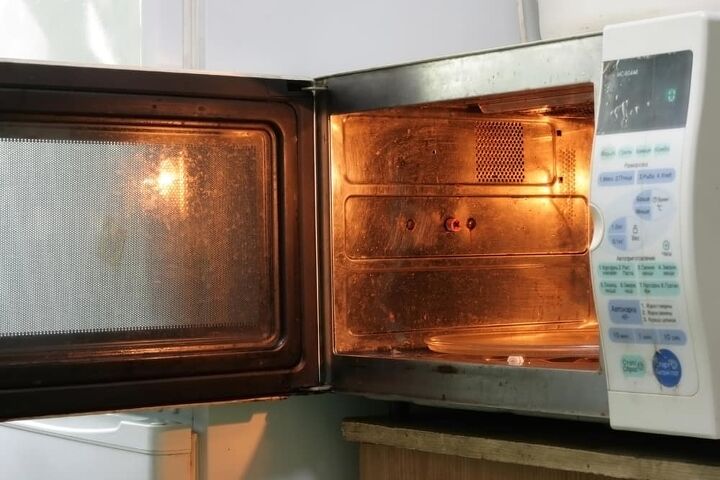How To Dispose Of A Microwave (3 Eco-Friendly Options)

Not many years ago, a microwave in the kitchen was considered a luxury item. Now, if you find a kitchen without a microwave, it would be a rarity. With the explosion in the popularity of microwaves has come an equally large problem of their disposal. How do you dispose of a microwave?
Three options exist for the disposal of microwave ovens. If the microwave is operating, you can sell them or donate them to a charity. If the unit is not working, scrapping and recycling is the best option.
In today’s environmentally conscious world, many communities tightly control what can and cannot go into the landfill. Most communities have restrictions on large appliances, including microwaves. Finding alternative methods of disposing of larger appliances can be challenging
Do You Need a Dumpster Rental Service?
Get free, zero-commitment quotes from pro contractors near you.

The Biggest Challenge – A Broken Microwave
Disposing of a microwave that no longer works is the biggest challenge. For many years, the solution was to take the broken appliance to the dump or landfill. The advent of federal and local restrictions on landfill material has brought that practice to an end.
Unlike refrigerators, microwaves contain only trace amounts of hazardous materials. However, in many states, this small amount of material classifies as Hazardous Household Waste. California, Oregon, New York, and New Jersey all have extensive lists of appliances that must be recycled.
The Options for Recycling a Broken Microwave
The growth of restrictions on how you can dispose of broken appliances has fostered growth in the recycling industry. This growth means more options for recycling broken or damaged appliances.
Charity Donations
Some charity organizations will take damaged or broken microwaves that they deem repairable. These organizations create jobs by offering appliance repair training. The repaired appliances are then sold in thrift stores to sustain the operation.
If the charity is a 501C(3), you can take a tax deduction for the donation. Be sure to ask the charitable organization for a donation receipt.
Commercial Recycling Centers
Many commercial recyclers are glad to take broken or damaged microwaves. These companies recognize the value of the material in the microwave. These companies disassemble the broken microwave and salvage the recyclable material and dispose of the rest. Many times, these companies will take your microwave at no charge.
Community Recycling Programs
Many communities have recycling programs that are part of the waste disposal services for the city or county. Check with your local waste management department for more information about these programs.
Many communities host a local drop-off point for large appliances, including microwaves. Some community waste management departments host neighborhood cleanup days. During these events, the city will spot large containers around your neighborhood for larger items.
Scrap it Yourself
According to GE, microwave ovens do not contain significant amounts of any hazardous materials. A microwave oven is perfectly safe for you to disassemble for scrap. There are some other safety considerations. Following a few systematic steps can leave you with several recyclable material types that may have some value.
Step 1 – What You Will Need
To disassemble your microwave and scavenge any materials of value requires some tools and safety equipment. You will need the following.
- You will need screwdrivers, both Phillips and straight types. Check the size of the screws on the microwave to help determine what size screwdrivers you need.
- You may need nut drivers to remove hex screws. Some microwaves use sheet metal screws that have hex heads to hold the case onto the chassis.
- Have a sharp pair of wire cutters. You won’t need huge cable cutters. Most of the wires inside the microwave are small, and a pair of smaller side cutters will work.
- Pliers for grasping and pulling. Many of the plastic components have mounting systems that plug into holes. The best way to remove them is to grab with a pair of pliers and pull.
- Get some containers for different types of recyclables. You will need to sort your recyclables into material types. Plastic bins or paper grocery sacks work well.
- Protective glasses are a must. You will be cutting wire and pulling plastic parts. Protect your eyes from small flying fragments.
- Wear good gloves. The sheet metal and other parts of the microwave can have sharp edges. A good pair of gloves can save you days of nagging painful cuts.
Once you have your tools and safety equipment, you are ready to begin scrapping your microwave.
Step 2 – Unplug the Microwave
Never work on a microwave or any other appliance without removing the power source. This is especially true of microwave ovens. The power system inside the microwave uses a high energy capacitor.
Capacitors such as these can store enormous amounts of electricity for long periods. Handling a charged capacitor is dangerous. The capacitor can deliver a lethal shock without warning. To be sure the capacitor fully discharges, leave the microwave unplugged for 24 hours before starting your scrapping project.
Step 3 – Cut the Power Cord
Before you proceed, use your wire cutters and cut the power cord as close to the microwave’s back as possible. Cutting the power cord prevents any possibility that the microwave gets plugged in during your project.
Put the power cord in your copper recycling bin. Copper is a valuable resource, and some recyclers will pay a premium for copper.
Step 4 – Remove Any Shelves or Racks
Most microwaves have a glass rotating shelf. Remove the glass shelf and set it aside. The glass shelf is probably of tempered glass. Many recycling centers want this harder glass kept separate.
If there are plastic parts inside the microwave cooking area, remove all of these and set them aside. Some plastics are recyclable. Your recycling center can tell which plastic parts will recycle.
Step 5 – Open the Case of the Microwave
This step may take some investigation. Every model of microwave is a bit different. Usually, a set of screws along the back and sides allows you to lift off the metal case. Use a magnet to check the metal case. Steel will attract the magnet. Aluminum and stainless steel will not. Put the metal case in the appropriate pile of recyclable metals.
Step 7 – The Scrapping Process
Before you begin, take a good look at the inside of your microwave. Many of the components of the microwave may have more value than just scrap. Many of the parts may still be good. These parts frequently sell online. Selling used parts may be another way to recover some value from your broken microwave.
Step 8 – Work Safe
Pay attention to any warning labels that you see inside the microwave. If parts are labeled no recyclable or do not remove, follow the instructions on the labels. Be aware of the capacitor. It is best to avoid the capacitor unless you are sure it holds no charge.
Step 9 – What to Remove
Anything copper has value. Remove as much of the wiring as possible and set it aside. The circuit boards and electronic components need special handling. Remove these electronic parts and set them aside separately.
Look for a large transformer. Transformers contain a large quantity of copper windings that can be valuable. Remove the transformer and put it in your copper pile.
Remove any plastics or insulation that may be inside the microwave. Typically, this material is not recyclable and can go into your household trash.
Motors and fans may have value if they are still operating. In any case, they contain copper windings that are salvageable.
Step 10 – Off to the Salvage Yard
Take your disassembled microwave to a metal salvage yard. The employees at the salvage yard will inspect your different groups of materials. You will get a small payment for the scrap value of the materials.
If Your Microwave Still Operates, Consider Other Options
If your microwave is still operating, there are other options to consider. The object is always to keep anything out of the landfill that still has value.
Sell It
You may find a healthy local market for used appliances, especially microwaves. A visit to the local flea market may leave you without a microwave and a few dollars in your pocket. The cost of a small advertisement in a local thrift newspaper will often return more than enough to pay for the ad.
Donate It
Many local charities operate thrift stores to fund a portion of their operations. A donation to such as charity provides jobs and opportunities in your community. If the charity is an IRX 502C(3) corporation, you can receive a tax break from your donation. Be sure to ask the charity for a donation receipt.
Do You Need a Dumpster Rental Service?
Get free, zero-commitment quotes from pro contractors near you.

The Real Object
The real objective is to keep the recyclable materials out of your local landfill. If you can make a few extra dollars along the way, that is great. But don’t lose sight of the real problem. Appliances can quickly become a problem for landfill operations if not disposed of properly.
We hope that this article has answered your question about how to dispose of a microwave. There are many options from which you can choose. Be careful and work safely.

Dennis is a retired firefighter with an extensive background in construction, home improvement, and remodeling. He worked in the trades part-time while serving as an active firefighter. On his retirement, he started a remodeling and home repair business, which he ran for several years.
More by Dennis Howard













![10 Best Zero Turn Mowers – [2022 Reviews & Ultimate Buyer's Guide]](https://cdn-fastly.upgradedhome.com/media/2023/07/31/9070522/10-best-zero-turn-mowers-2022-reviews-ultimate-buyer-s-guide.jpg?size=350x220)













